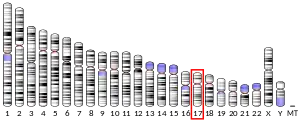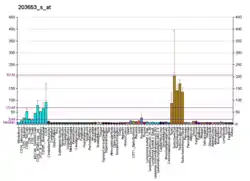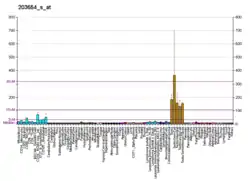| COIL | |||||||||||||||||||||||||||||||||||||||||||||||||||
|---|---|---|---|---|---|---|---|---|---|---|---|---|---|---|---|---|---|---|---|---|---|---|---|---|---|---|---|---|---|---|---|---|---|---|---|---|---|---|---|---|---|---|---|---|---|---|---|---|---|---|---|
| Identifiers | |||||||||||||||||||||||||||||||||||||||||||||||||||
| Aliases | COIL, Coil, C79982, Cln80, p80, p80-coilin, coilin | ||||||||||||||||||||||||||||||||||||||||||||||||||
| External IDs | OMIM: 600272 MGI: 104842 HomoloGene: 3413 GeneCards: COIL | ||||||||||||||||||||||||||||||||||||||||||||||||||
| |||||||||||||||||||||||||||||||||||||||||||||||||||
| |||||||||||||||||||||||||||||||||||||||||||||||||||
| |||||||||||||||||||||||||||||||||||||||||||||||||||
| |||||||||||||||||||||||||||||||||||||||||||||||||||
| |||||||||||||||||||||||||||||||||||||||||||||||||||
| Wikidata | |||||||||||||||||||||||||||||||||||||||||||||||||||
| |||||||||||||||||||||||||||||||||||||||||||||||||||
Coilin is a protein that in humans is encoded by the COIL gene.[5][6] Coilin got its name from the coiled shape of the Cajal bodies in which it is found. It was first identified using human autoimmune serum.
Function
Coilin protein is one of the main molecular components of Cajal bodies. Cajal bodies are non-membrane bound nuclear bodies of varying number and composition that are involved in the post-transcriptional modification of small nuclear and small nucleolar RNAs. In addition to its structural role, coilin acts as glue to connect the CB to the nucleolus. The N-terminus of the coilin protein directs its self-oligomerization while the C-terminus influences the number of nuclear bodies assembled per cell. Differential methylation and phosphorylation of coilin likely influences its localization among nuclear bodies and the composition and assembly of Cajal bodies. This gene has pseudogenes on chromosome 4 and chromosome 14.[6]
To study CBs, coilin can be combined with GFP (Green Fluorescent Protein) to form Coilin-GFP hybrid protein. The hybrid protein can then be used to locate CBs underneath a microscope, usually near the nucleolus of the cell. Other proteins that make up the CB include snRNPs and nucleolar snoRNPs.
Coilin has been shown to interact with ataxin 1,[7][8] nucleolar phosphoprotein p130,[9] SMN,[10][11] and SNRPB.[11]
References
- 1 2 3 GRCh38: Ensembl release 89: ENSG00000121058 - Ensembl, May 2017
- 1 2 3 GRCm38: Ensembl release 89: ENSMUSG00000033983 - Ensembl, May 2017
- ↑ "Human PubMed Reference:". National Center for Biotechnology Information, U.S. National Library of Medicine.
- ↑ "Mouse PubMed Reference:". National Center for Biotechnology Information, U.S. National Library of Medicine.
- ↑ Chan EK, Takano S, Andrade LE, Hamel JC, Matera AG (Dec 1994). "Structure, expression and chromosomal localization of human p80-coilin gene". Nucleic Acids Res. 22 (21): 4462–9. doi:10.1093/nar/22.21.4462. PMC 308480. PMID 7971277.
- 1 2 "Entrez Gene: COIL coilin".
- ↑ Hong S, Ka S, Kim S, Park Y, Kang S (May 2003). "p80 coilin, a coiled body-specific protein, interacts with ataxin-1, the SCA1 gene product". Biochim. Biophys. Acta. 1638 (1): 35–42. doi:10.1016/s0925-4439(03)00038-3. PMID 12757932.
- ↑ Hong S, Lee S, Cho SG, Kang S (Jun 2008). "UbcH6 interacts with and ubiquitinates the SCA1 gene product ataxin-1". Biochem. Biophys. Res. Commun. 371 (2): 256–60. doi:10.1016/j.bbrc.2008.04.066. PMID 18439907.
- ↑ Isaac C, Yang Y, Meier UT (Jul 1998). "Nopp140 functions as a molecular link between the nucleolus and the coiled bodies". J. Cell Biol. 142 (2): 319–29. doi:10.1083/jcb.142.2.319. PMC 2133063. PMID 9679133.
- ↑ Hebert MD, Shpargel KB, Ospina JK, Tucker KE, Matera AG (Sep 2002). "Coilin methylation regulates nuclear body formation". Dev. Cell. 3 (3): 329–37. doi:10.1016/s1534-5807(02)00222-8. PMID 12361597.
- 1 2 Hebert MD, Szymczyk PW, Shpargel KB, Matera AG (Oct 2001). "Coilin forms the bridge between Cajal bodies and SMN, the spinal muscular atrophy protein". Genes Dev. 15 (20): 2720–9. doi:10.1101/gad.908401. PMC 312817. PMID 11641277.
Further reading
- Ogg SC, Lamond AI (October 14, 2002). "Cajal bodies and coilin — moving towards function". J. Cell Biol. 159 (1): 17–21. doi:10.1083/jcb.200206111. PMC 2173504. PMID 12379800.
- Andrade LE, Chan EK, Raska I, Peebles CL, Roos G, Tan EM (1991). "Human autoantibody to a novel protein of the nuclear coiled body: immunological characterization and cDNA cloning of p80-coilin". J. Exp. Med. 173 (6): 1407–19. doi:10.1084/jem.173.6.1407. PMC 2190846. PMID 2033369.
- Bohmann K, Ferreira JA, Lamond AI (1996). "Mutational analysis of p80 coilin indicates a functional interaction between coiled bodies and the nucleolus". J. Cell Biol. 131 (4): 817–31. doi:10.1083/jcb.131.4.817. PMC 2200013. PMID 7490287.
- Carmo-Fonseca M, Ferreira J, Lamond AI (1993). "Assembly of snRNP-containing coiled bodies is regulated in interphase and mitosis--evidence that the coiled body is a kinetic nuclear structure". J. Cell Biol. 120 (4): 841–52. doi:10.1083/jcb.120.4.841. PMC 2200076. PMID 7679389.
- Robertson NG, Khetarpal U, Gutiérrez-Espeleta GA, Bieber FR, Morton CC (1995). "Isolation of novel and known genes from a human fetal cochlear cDNA library using subtractive hybridization and differential screening". Genomics. 23 (1): 42–50. doi:10.1006/geno.1994.1457. PMID 7829101.
- Kusuda J, Tanuma R, Gotoh E, Toyoda A, Hashimoto K (1995). "Assignment of a human autoimmune antigen, p80-coilin gene to chromosome 17q21-q23 and of its possible pseudogene to chromosome 14". Hum. Genet. 95 (2): 233–4. doi:10.1007/BF00209411. PMID 7860074. S2CID 20006429.
- Lyon CE, Bohmann K, Sleeman J, Lamond AI (1997). "Inhibition of protein dephosphorylation results in the accumulation of splicing snRNPs and coiled bodies within the nucleolus". Exp. Cell Res. 230 (1): 84–93. doi:10.1006/excr.1996.3380. PMID 9013710.
- Parfenov VN, Davis DS, Pochukalina GN, Kostyuchek D, Murti KG (1998). "Dynamics of distribution of splicing components relative to the transcriptional state of human oocytes from antral follicles". J. Cell. Biochem. 69 (1): 72–80. doi:10.1002/(SICI)1097-4644(19980401)69:1<72::AID-JCB8>3.0.CO;2-S. PMID 9513048. S2CID 29105448.
- Pochukalina GN, Davis DS, Kostiuchek DF, Murti KG, Parfenov VN (1998). "[Splicing factors in oocyte nuclei from human antral follicles]". Tsitologiia. 40 (4): 239–47. PMID 9644758.
- Isaac C, Yang Y, Meier UT (1998). "Nopp140 functions as a molecular link between the nucleolus and the coiled bodies". J. Cell Biol. 142 (2): 319–29. doi:10.1083/jcb.142.2.319. PMC 2133063. PMID 9679133.
- Liu J, Hebert MD, Ye Y, Templeton DJ, Kung H, Matera AG (2000). "Cell cycle-dependent localization of the CDK2-cyclin E complex in Cajal (coiled) bodies". J. Cell Sci. 113 (9): 1543–52. doi:10.1242/jcs.113.9.1543. PMID 10751146.
- Hebert MD, Matera AG (2001). "Self-association of coilin reveals a common theme in nuclear body localization". Mol. Biol. Cell. 11 (12): 4159–71. doi:10.1091/mbc.11.12.4159. PMC 15064. PMID 11102515.
- Young PJ, Le TT, Dunckley M, Nguyen TM, Burghes AH, Morris GE (2001). "Nuclear gems and Cajal (coiled) bodies in fetal tissues: nucleolar distribution of the spinal muscular atrophy protein, SMN". Exp. Cell Res. 265 (2): 252–61. doi:10.1006/excr.2001.5186. PMID 11302690.
- Hebert MD, Szymczyk PW, Shpargel KB, Matera AG (2001). "Coilin forms the bridge between Cajal bodies and SMN, the spinal muscular atrophy protein". Genes Dev. 15 (20): 2720–9. doi:10.1101/gad.908401. PMC 312817. PMID 11641277.
- Andersen JS, Lyon CE, Fox AH, Leung AK, Lam YW, Steen H, Mann M, Lamond AI (2002). "Directed proteomic analysis of the human nucleolus". Curr. Biol. 12 (1): 1–11. doi:10.1016/S0960-9822(01)00650-9. PMID 11790298. S2CID 14132033.
- Sleeman JE, Ajuh P, Lamond AI (2002). "snRNP protein expression enhances the formation of Cajal bodies containing p80-coilin and SMN". J. Cell Sci. 114 (Pt 24): 4407–19. doi:10.1242/jcs.114.24.4407. PMID 11792806.
- Hebert MD, Shpargel KB, Ospina JK, Tucker KE, Matera AG (2002). "Coilin methylation regulates nuclear body formation". Dev. Cell. 3 (3): 329–37. doi:10.1016/S1534-5807(02)00222-8. PMID 12361597.
- Shpargel KB, Ospina JK, Tucker KE, Matera AG, Hebert MD (2003). "Control of Cajal body number is mediated by the coilin C-terminus". J. Cell Sci. 116 (Pt 2): 303–12. doi:10.1242/jcs.00211. PMID 12482916. S2CID 24967810.
- Sleeman JE, Trinkle-Mulcahy L, Prescott AR, Ogg SC, Lamond AI (2004). "Cajal body proteins SMN and Coilin show differential dynamic behaviour in vivo". J. Cell Sci. 116 (Pt 10): 2039–50. doi:10.1242/jcs.00400. PMID 12679382. S2CID 9085320.
- Hearst SM, Gilder AS, Negi SS, Davis MD, George EM, Whittom AA, Toyota CG, Husedzinovic A, Gruss OJ, Hebert MD (2009). "Cajal-body formation correlates with differential coilin phosphorylation in primary and transformed cell lines". J. Cell Sci. 122 (Pt 11): 1872–81. doi:10.1242/jcs.044040. PMC 2684838. PMID 19435804.
This article incorporates text from the United States National Library of Medicine, which is in the public domain.





